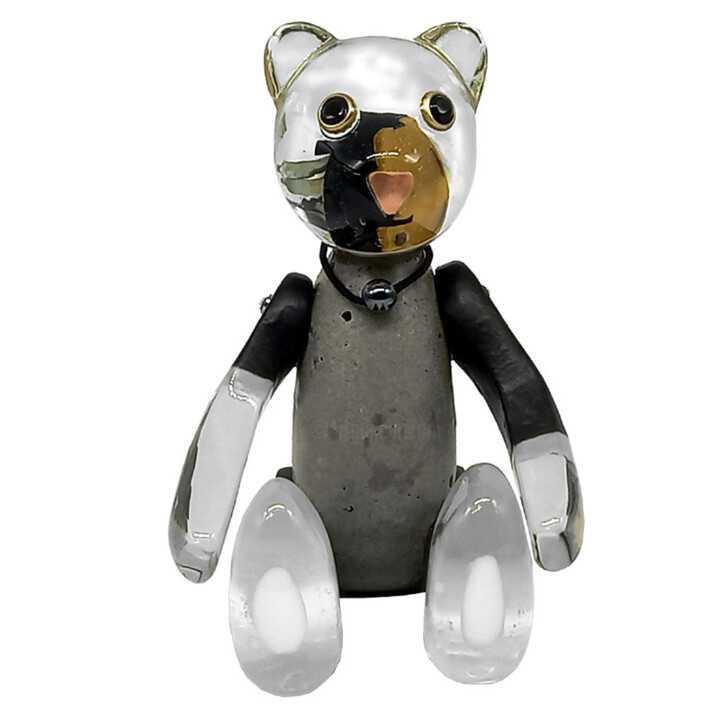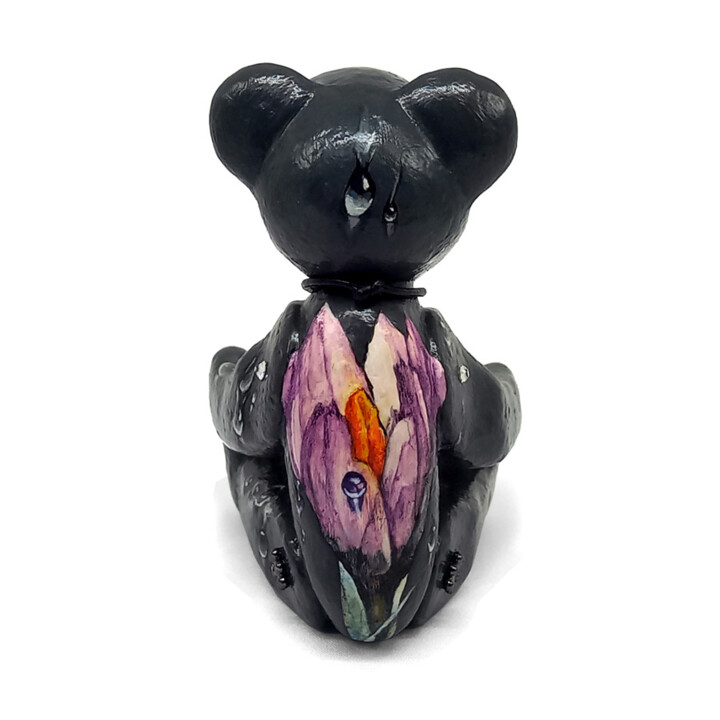34 Oryginalne współczesne rzeźby na sprzedaż:
Jakie jest pochodzenie Żywica techniki?
Niezależnie od tego, czy są to żywice syntetyczne, czy żywica rzeźbiarska, rzeźby z żywicy są okazją dla artystów wizualnych do ożywienia figurek, statuetek i innych przedmiotów o ogólnie zmniejszonych rozmiarach. Po zmieszaniu składników pasta żywiczna wysycha na powietrzu i staje się bardzo twarda, a następnie można ją obrabiać i malować zgodnie z inspiracją artysty rzeźbiarza.
Jak zdefiniować Land Art / Sztuka ziemi styl ?
Land art, zwany także earth artem, powstaje bezpośrednio w krajobrazie, rzeźbiąc go lub budując w nim konstrukcje z materiałów naturalnych. Land art był protestem przeciwko „bezwzględnej komercjalizacji” sztuki w Ameryce w latach 60. i 70. XX wieku. Dokumentacja fotograficzna była jednak często eksponowana w konwencjonalnych przestrzeniach galeryjnych. W tym czasie zwolennicy land artu odrzucili muzeum czy galerię jako miejsce działań artystycznych i stworzyli monumentalne projekty krajobrazowe, które wykraczały poza zakres tradycyjnej przenośnej rzeźby i komercyjnego rynku sztuki. Sztuka minimalistyczna i konceptualna, a także współczesne trendy, takie jak De Stijl, kubizm, minimalizm, czy twórczość Constantina Brâncuși i Josepha Beuysa, posłużyły za inspirację dla Land artu.
Głównymi problemami ruchu artystycznego był sprzeciw wobec komercjalizacji sztuki i entuzjazm dla nowo powstającego ruchu ekologicznego. Dominacja nastrojów antymiejskich i przeciwstawiająca się im pasja do życia na wsi zbiegła się z ruchem artystycznym. Wśród tych impulsów były duchowe aspiracje, aby Ziemia służyła jako dom ludzkości.
Oparta na procesach metoda tworzenia sztuki, w ramach której artysta wyruszał na wycieczki do otaczającego środowiska w celu kolekcjonowania przedmiotów lub przeprowadzania interwencji specyficznych dla danego miejsca, szybko ewoluowała od tego, co początkowo zaczęło się jako trend w rzeźbie, polegający na włączaniu naturalnych materiałów, takich jak brud, skały i rośliny. Podczas gdy niektórzy artyści tworzyli tymczasowe, ograniczone interwencje w krajobraz, inni używali mechanicznego sprzętu do robót ziemnych do tworzenia swoich prac ziemnych. Do prezentacji w galeriach artyści często wykorzystywali fotografie, filmy i mapy do dokumentowania swoich prac ziemnych. Dodatkowo, poprzez łączenie organicznych elementów otoczenia w rzeźby i instalacje, landartowcy tworzyli w galeriach land art.
Pierwszym amerykańskim muzeum, które zaprezentowało wystawę sztuki ziemi, zatytułowaną po prostu Earth Art, było Muzeum Sztuki Herberta F. Johnsona na Uniwersytecie Cornell w lutym 1969 roku. Dzieła sztuki można było oglądać w muzeum, a także w całym kampusie Itaki Uniwersytetu Cornell , zapewniając miejsce dla dzieł, które później nadal kwestionowały status sztuki jako towaru, zwłaszcza tych instalacji, które zacierały granice między kontekstem obiektu a jego otoczeniem.
Rzeźba sztuki lądowej
Artyści ziemi badali granice sztuki, często aktywnie zmieniając krajobraz, tworząc swoje rzeźby i instalacje. Te dzieła sztuki były często rzeźbione bezpośrednio z ziemi lub przekształcane w dzieła sztuki ziemnej przez artystę wykorzystującego dostępne zasoby naturalne. Wykorzystanie tych elementów uhonorowało wyjątkowość miejsca i obejmowało ziemię, rośliny, skały, żwir, kamienie, gałązki i wodę, które często znajdowano na miejscu.
Powstała sztuka Ziemi wprowadziła do świata sztuki ideę specyfiki lokalizacji. Ze względu na to, że dzieła te nie zawsze były dostępne dla zwiedzających, a artyści byli czasami jedynymi osobami świadomymi ich istnienia, rzeźby te stawiały artystów w centrum ich twórczości. W rezultacie artyści często dokumentują swoją pracę za pomocą fotografii, które następnie wykorzystują do wystawiania w galeriach sztuki zamiast swoich rzeczywistych prac.
Ponieważ ruch Land Art sprzeciwiał się brutalnej komercjalizacji sztuki w latach 60., ta zmiana otoczenia podważyła pogląd, że sztuka istnieje wyłącznie jako coś, co należy obserwować. Prace te badały powrót do natury, co zapoczątkowało rozwój ruchu ekologicznego, uznającego Ziemię za prawdziwy dom ludzkości. W rezultacie artyści z Landu zaczęli tworzyć sztukę ziemi, która gloryfikowała ten ideał i była całkowitym odrzuceniem wielkomiejskiego życia.
Ponieważ tradycyjne miejsca działalności artystycznej, muzea i galerie, zostały porzucone, artyści otrzymali możliwość tworzenia monumentalnych rzeźb, które wykraczały poza zakres tradycyjnych przenośnych dzieł sztuki. Artyści ziemscy byli zmuszeni polegać na systemie, którego nienawidzili, w celu wspierania ich kosztownych pomysłów w celu tworzenia rzeźb i instalacji poza konwencjonalnymi lokalizacjami galerii i muzeów. Ogromne instalacje krajobrazowe często wymagały zakupu ziemi i użycia narzędzi do robót ziemnych; zamożni mecenasi i prywatne fundacje często zapewniali fundusze na te ekstrawaganckie projekty.
Rzeźbiarze sztuki lądowej
Roberta Smithsona (1938-1973)
Amerykański artysta Robert Smithson był prawdopodobnie jednym z najważniejszych pionierów tego ruchu. W odpowiedzi na wycofanie się modernizmu z kwestii społecznych, jego esej „The Sedimentation of the Mind: Earth Projects” z 1968 r. Przedstawił krytyczne ramy dla ruchu. Aby tworzyć trójwymiarowe kompozycje rzeźbiarskie zaczął łączyć różne materiały. Doprowadziło to do serii prac „nie-miejscowych”, w których rzeźby wykonane z ziemi i skał przywiezionych z wypraw zostały umieszczone w galeriach. Rzeźby te często zawierały mapy, kosze, lustra, szkło i neony. Roboty ziemne Smithsona Spiral Jetty (1970), Broken Circle / Spiral Hill (1971) i Amarillo Ramp (1973) to jego najsłynniejsze dzieła (1973). Całkowicie usuwając sztukę z kontekstu galerii i integrując ją z naturalnym terenem, na zawsze zmienił z góry przyjęte koncepcje formy rzeźbiarskiej w sztuce współczesnej.
Walter De Maria (1935-2013)
W swoich rzeźbach, instalacjach i pracach ziemnych Walter de Maria wykorzystywał formy geometryczne do tworzenia serii powtórzeń, które badały związek między względnością a absolutem. Lighting Field (1977), jego najbardziej znane dzieło sztuki lądowej, to siatka kwadratów o wymiarach jednej mili na kilometr, umieszczona w odległej części pustyni w Nowym Meksyku. Czterysta słupów wykonanych z polerowanej stali nierdzewnej, które mają ponad dwadzieścia stóp wysokości i mają spiczaste końcówki, które wyznaczają płaszczyznę poziomą - punkt przyciągania uderzeń piorunów - tworzą siatkę. Odwiedzający może wejść do siatki fizycznie lub obserwować ją z daleka, w serii potężnych iluzji optycznych, które zmieniają się w czasie i przestrzeni, zderzają się sztuka, krajobraz i natura.
Dennis Oppenheim (1938-2011)
Wczesne interwencje Oppenheima w świat przyrody, w przeciwieństwie do wielu jego współczesnych, przybrały formę usuwania, powrotu do tradycyjnej rzeźbiarskiej zasady rzeźbienia poprzez, jak sam mówi artysta, „zabieranie, a nie dodawanie”. Granice geopolityczne, strefy czasowe i naturalna degradacja to tylko kilka przykładów systemów społecznych i naturalnych, do których odwołuje się i podkreśla w Annual Rings (1968), pracy specyficznej dla danego miejsca. Reprodukcja mapy służy pokazaniu, w jaki sposób mapowanie odgrywa rolę w tworzeniu nienaturalnych i często gwałtownych granic między państwami, a rzeka, naturalna granica, służy jako narzędzie dla tych międzynarodowych granic.
Oppenheim zakwestionował „względne wartości systemów porządkujących, według których żyjemy”, zestawiając naturalne elementy ze sztucznymi ideami, takimi jak narodowość i strefy czasowe. W tym samym czasie artyści zajmujący się ziemią, tacy jak Robert Smithson i Walter de Maria, tworzyli również prace ziemne specyficzne dla danego miejsca, w których środowisko naturalne zostało skonfliktowane ze sztucznymi interwencjami.
Nancy Holt (1938-2014)
Najbardziej znane są publiczne rzeźby, instalacje i Land Art, które Holt stworzyła w trakcie swojej kariery, wraz z niektórymi jej eksperymentalnymi filmami i fotografiami. Aby kontynuować pomysłowość i ciekawość prac zarówno jej, jak i jej męża (Roberta Smithsona), Holt założyła w 2017 roku Fundację Holt/Smithson. Poprzez swoją praktykę rzeźbiarską stworzyli nowe podejście do badania naszego związku ze światem.
Richard Long (ur. 1945)
Znanym brytyjskim rzeźbiarzem związanym z ruchem Land Art był Richard Long. Pod koniec lat 60. artysta rozpoczął bezpośrednią interakcję z naturą, wykorzystując spacer jako medium, motywowany chęcią wykorzystania krajobrazu w nowy sposób. Długo próbował obalić język i aspiracje sztuki i sprowadzić ją na bardziej podstawowy, intymny i fundamentalny poziom poprzez sekwencję powtarzalnych gestów lub przedłużające się solowe spacery. Jego celem było zilustrowanie na sobie możliwości niezafałszowanej rozmowy między człowiekiem a środowiskiem. Czas, przestrzeń i odległość są tematami tego przełomowego konceptualnego projektu sztuki lądowej i zostały rozszerzone na masową skalę.
Andy Goldsworthy (ur. 1956)
Andy Goldsworthy jest znanym rzeźbiarzem i fotografem, który pracuje w naturze i z nią. Jego twórczość można podzielić na projekty stałe i tymczasowe. Te ostatnie są zaprojektowane tak, aby znikały pod koniec cyklu życia i są zbudowane z organicznych i przejściowych składników. Tworzy wiele powtarzalnych projektów, w tym spirale, koła i wijące się linie, z gałęzi, liści, skał i lodu. Efemeryczność w centrum tych inicjatyw jest odzwierciedleniem delikatnej ekologii i nieustannie zmieniającego się środowiska naturalnego.
Jak kupić rzeźbę z żywicy przez Internet?
Rzeźba z żywicy to idealna nowoczesna grafika do wystroju wnętrza Twojego domu. Rzeźby z żywicy są super modne i artystycznie wywodzące się ze stylów Pop-art i Street art.
Dzięki szerokiej gamie dostępnych kolorów i kształtów, rzeźba z żywicy jest po prostu tak nowoczesna i przyciąga wzrok. Będziesz zachwycony błyszczącymi i nieskazitelnymi cechami każdej rzeźby z żywicy.
Rzeźby z żywicy są tak nowoczesnymi dziełami sztuki, że mogą pozostać w pomieszczeniach i na zewnątrz. Żywica to błyszczący i trwały materiał, który wnosi fantazję i kreatywność do sztuki współczesnej.
Ogromnie wzrasta upodobanie do rzeźb z żywicy. Jeśli jesteś zainteresowany kupnem rzeźby z żywicy przez Internet , zapraszamy do odwiedzenia naszej strony internetowej ARTMAJEUR.COM i przeglądania naszych tysięcy rzeźb z żywicy.
Oferujemy szeroką gamę rzeźb dostępnych w sprzedaży online . Niezależnie od tego, czy jesteś uzależnionym kolekcjonerem, czy zaczynasz kupować sztukę, na pewno znajdziesz rzeźbę z żywicy do kupienia online , z której będziesz cieszyć się przez całe życie.
Discover contemporary artworks on ArtMajeur
Contemporary art is a vibrant constellation of artistic expressions. This creative universe encompasses a wide array of mediums, from paintings, sculpture, and photography to drawing, printmaking, textile art, and digital art, each medium a star shining with its own distinct radiance. Artists use diverse supports and materials to bring their visions to life, such as canvas, wood, metal, and even innovative digital canvases for the creation of virtual masterpieces.
A contemporary painting, for instance, may weave its story through the masterful strokes of acrylic or oil, while a contemporary sculpture might sing its song in the language of stone, bronze, or found objects. The photographic arts capture and manipulate light to produce striking images, while printmaking employs techniques like lithography and screen-printing to produce multiples of a single, impactful image. Textile art plays with fabrics and fibers, whereas digital art pushes the boundaries of creation with innovative technology.
The allure of contemporary art lies in its boundary-pushing nature, its relentless quest for experimentation and its constant reflection of the evolving human experience. This boundless creativity, coupled with its strong social and personal commentary, makes every piece of contemporary art a unique emblem of its time, a mirror held up to the realities and dreams of our complex world. It whispers to us, moves us, provokes thought, and kindles a deep emotional response, stirring the soul of anyone willing to listen. It is, indeed, the language of emotions and ideas, spoken in the dialect of our era.

©2020 Seven E
Origins and history of contemporary art
The story of contemporary art unfolds in the mid-20th century, marked by seismic shifts in artistic expression. Post-World War II, around the 1950s and 1960s, artists began experimenting beyond traditional confines, challenging the norms of what art could be. This revolutionary epoch birthed myriad new movements and artistic forms such as abstract expressionism, pop art, and minimalism. Paintings, once confined by realism, embraced abstraction, as artists used color and form to express emotions and ideas. Notable periods like the advent of pop art in the late 1950s and early 1960s saw artworks mimicking popular culture and mass media, reflecting society’s shifting focus.
The sculptural arts, too, witnessed a metamorphosis. Sculptors started to experiment with new materials and forms, often creating artworks that interacted with the viewer and the surrounding space, fostering a sense of engagement. Drawing, a timeless practice, also evolved, with artists incorporating innovative techniques and concepts to redefine its role in contemporary art.
Photography, a relatively new medium, emerged as a powerful tool in the contemporary art landscape. Born in the 19th century, it truly came into its own in the latter half of the 20th century, blurring the lines between fine art and documentation. Printmaking, a practice dating back to ancient times, saw renewed interest and experimentation with techniques like lithography, etching, and screen printing gaining prominence.
The realm of textile art expanded dramatically, as artists began to appreciate the versatility and tactile quality of fabric and fibers. Artists began using textiles to challenge the boundaries between fine art, craft, and design.
The dawn of digital technology in the late 20th century heralded a new age for contemporary art. Digital art emerged as artists started leveraging new technologies to create immersive, interactive experiences, often blurring the line between the virtual and the physical world.
Through these transformative periods, the essence of contemporary art has remained the same: a dynamic, evolving reflection of the times we live in, continually pushing boundaries and embracing the new, always questioning, always exploring.

©2016 Seven E
Evolutions of theses contemporary works in the art market
As we navigate through the 21st century, the dynamic landscape of contemporary art continues to evolve and expand, reflecting our ever-changing world. Contemporary paintings, once primarily confined to two-dimensional canvases, now embrace a multitude of forms and techniques, ranging from mixed media installations to digital creations, each piece a rich a weaving of thoughts, emotions, and narratives. Sculpture, too, has ventured far beyond traditional stone and bronze, with artists incorporating light, sound, and even motion, embodying the ephemerality and flux of the modern world.
Photography, in the hands of contemporary artists, has expanded its horizons, seamlessly blending with digital technology to create breathtaking imagery that challenges our perception of reality. Drawing, as well, has transcended the borders of paper, incorporating multimedia elements and exploratory techniques to redefine its role in the artistic discourse. Printmaking continues to flourish, with contemporary artists using traditional methods in innovative ways to deliver potent social and personal commentaries.
Textile art, once considered a craft, now holds a prominent place in the contemporary art world, with artists using it to explore issues of identity, tradition, and cultural heritage. Meanwhile, digital art, the newest member of the contemporary art family, has revolutionized the way we create and interact with art, presenting immersive experiences that blur the boundary between the virtual and the physical.
These diverse forms of contemporary art hold significant value in the current art market, not only due to their aesthetic appeal but also their ability to encapsulate and communicate complex ideas and emotions. Collectors, curators, and art lovers worldwide seek these works, drawn to their inherent dynamism, their innovative use of materials, and their eloquent expressions of our shared human experience. As a testimonial to our times, these contemporary artworks encapsulate the pulse of our society and the resonance of individual voices, forever etching our collective narrative into the annals of art history.

©2016 Seven E
Famous Contemporary Artists
As we delve into the vibrant realm of contemporary art, we encounter an array of artists who shape this dynamic field. Each a master in their medium - painting, sculpture, photography, drawing, printmaking, textile, or digital art - they push artistic boundaries, reflecting our era and challenging perceptions. Let’s explore these remarkable contributors and their groundbreaking works.
1. Gerhard Richter - Known for his multi-faceted approach to painting, Richter challenges the boundaries of the medium, masterfully oscillating between abstract and photorealistic styles. His works, whether featuring squeegee-pulled pigments or blurred photographic images, engage in a fascinating dialogue with perception.
2. Jeff Koons - A significant figure in contemporary sculpture, Koons crafts monumental pieces that explore themes of consumerism, taste, and popular culture. His iconic balloon animals, constructed in mirror-polished stainless steel, captivate with their playful yet profound commentary.
3. Cindy Sherman - An acclaimed photographer, Sherman uses her lens to explore identity and societal roles, particularly of women. Renowned for her conceptual self-portraits, she assumes myriad characters, pushing the boundaries of photography as a medium of artistic expression.
4. David Hockney - Hockney, with his prolific output spanning six decades, is a pivotal figure in contemporary drawing. His bold use of color and playful exploration of perspective convey an intoxicating sense of joy and an unabashed celebration of life.
5. Kiki Smith - An innovative printmaker, Smith’s work explores the human condition, particularly the female body and its social and cultural connotations. Her etchings and lithographs speak to universal experiences of life, death, and transformation.
6. El Anatsui - A master of textile art, Anatsui creates stunning tapestry-like installations from discarded bottle caps and aluminum scraps. These shimmering, flexible sculptures blend traditional African aesthetic with contemporary art sensibilities, speaking to themes of consumption, waste, and the interconnectedness of our world.
7. Rafael Lozano-Hemmer - A leading figure in digital art, Lozano-Hemmer utilizes technology to create interactive installations that blend architecture and performance art. His work, often participatory in nature, explores themes of surveillance, privacy, and the relationship between people and their environments.

©2016 Seven E
Notable contemporary artworks
The contemporary art landscape is a dynamic patchwork of diverse expressions and groundbreaking ideas, each artwork a unique dialog with its audience. Here are a selection of some renowned contemporary artworks, spanning various media such as painting, sculpture, photography, drawing, printmaking, textile art, and digital art, that have profoundly influenced this vibrant movement.
"Cloud Gate" by Anish Kapoor, 2006 - This monumental stainless steel sculpture, also known as "The Bean," mirrors and distorts the Chicago skyline and onlookers in its seamless, liquid-like surface, creating an interactive experience that blurs the line between the artwork and the viewer.
"Marilyn Diptych" by Andy Warhol, 1962 - An iconic piece of pop art, this silkscreen painting features fifty images of Marilyn Monroe. Half brightly colored, half in black and white, it reflects the dichotomy of celebrity life and its influence on popular culture.
"Rhein II" by Andreas Gursky, 1999 - This photographic artwork, a digitally-altered image of the Rhine River, is celebrated for its minimalist aesthetic. It strips the landscape to its bare essentials, invoking a sense of tranquility and vastness.
"Black Square" by Kazimir Malevich, 1915 - A revolutionary painting in the realm of abstract art, this piece, featuring nothing more than a black square on a white field, challenges traditional notions of representation, symbolizing a new era in artistic expression.
"Puppy" by Jeff Koons, 1992 - This giant sculpture, a West Highland Terrier blanketed in flowering plants, explores themes of innocence, consumer culture, and the interplay between high art and kitsch. It’s a delightful blend of traditional sculpture and garden craft.
"Re-projection: Hoerengracht" by Ed and Nancy Kienholz, 1983-1988 - A room-sized tableau representing Amsterdam’s red-light district, this work combines elements of sculpture, painting, lighting, and found objects. It engages viewers in a stark commentary on commodification and objectification.
"Untitled" (Your body is a battleground) by Barbara Kruger, 1989 - This photomontage, combining black-and-white photography with impactful text, explores issues of feminism, identity, and power. Its potent, confrontational message is a prime example of the power of text in contemporary visual art.
"For the Love of God" by Damien Hirst, 2007 - This sculpture, a platinum cast of a human skull encrusted with 8,601 diamonds, probes themes of mortality, value, and the human fascination with luxury and decadence. It’s a compelling blend of macabre and magnificence.
"Physical impossibility of Death in the Mind of Someone Living" by Damien Hirst, 1991 - This artwork, featuring a tiger shark preserved in formaldehyde, blurs the line between traditional sculpture and biological specimen. It prompts viewers to contemplate mortality and nature’s ferocity.
"One and Three Chairs" by Joseph Kosuth, 1965 - A piece of conceptual art, it presents a physical chair, a photograph of a chair, and a dictionary definition of a chair, thus exploring the relationship between language, picture, and referent in art.
These pieces, in their diversity, exemplify the rich tapestry of contemporary art, each piece a unique commentary on our world and a testament to the limitless potential of creative expression.

Seven E
Rzeźba - Żywica | 3,9x3,2 in

































